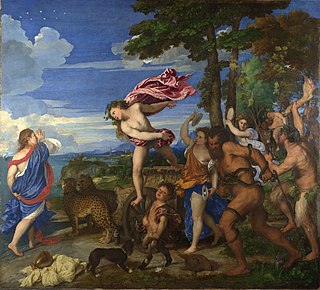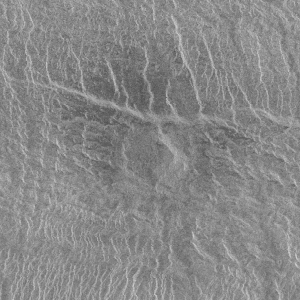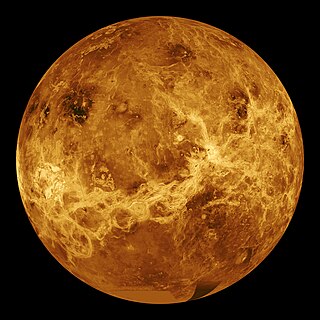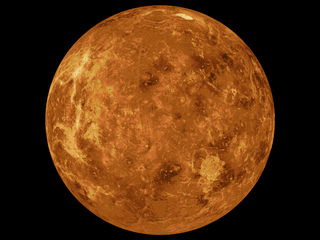
The geology of Venus is the scientific study of the surface, crust, and interior of the planet Venus. Within the Solar System, it is the one nearest to Earth and most like it in terms of mass, but has no magnetic field or recognizable plate tectonic system. Much of the ground surface is exposed volcanic bedrock, some with thin and patchy layers of soil covering, in marked contrast with Earth, the Moon, and Mars. Some impact craters are present, but Venus is similar to Earth in that there are fewer craters than on the other rocky planets that are largely covered by them. This is due in part to the thickness of the Venusian atmosphere disrupting small impactors before they strike the ground, but the paucity of large craters may be due to volcanic re-surfacing, possibly of a catastrophic nature. Volcanism appears to be the dominant agent of geological change on Venus. Some of the volcanic landforms appear to be unique to the planet. There are shield and composite volcanoes similar to those found on Earth, although these volcanoes are significantly shorter than those found on Earth or Mars. Given that Venus has approximately the same size, density, and composition as Earth, it is plausible that volcanism may be continuing on the planet today, as demonstrated by recent studies.
Ariadne was a figure in Greek mythology.

Bacchus and Ariadne (1522–1523) is an oil painting by Titian. It is one of a cycle of paintings on mythological subjects produced for Alfonso I d'Este, Duke of Ferrara, for the Camerino d'Alabastro – a private room in his palazzo in Ferrara decorated with paintings based on classical texts. An advance payment was given to Raphael, who originally held the commission for the subject of a Triumph of Bacchus.

Cleopatra is an impact crater on Venus, in Maxwell Montes. Cleopatra is a double-ring impact basin about 100 kilometers (62 mi) in diameter and 2.5 kilometers (1.6 mi) deep. A steep-walled, winding channel a few kilometers wide breaks through the rough terrain surrounding the crater rim. A large amount of lava originating in Cleopatra flowed through this channel and filled valleys in Fortuna Tessera. Cleopatra is superimposed on the structures of Maxwell Montes and appears to be undeformed, indicating that Cleopatra is relatively young. The crater is named after Egyptian queen Cleopatra VII.

Mead is an impact crater on Venus named in honor of the cultural anthropologist Margaret Mead.

Adivar is an impact crater on Venus, named in honor of Turkish writer Halide Edib Adıvar. The crater is located just north of the western Aphrodite highland. Surrounding the crater rim is ejected material which appears bright in the radar image due to the presence of rough fractured rock. A much broader area has also been affected by the impact, particularly to the west of the crater. Radar-bright materials, including a jet-like streak just west of the crater, extend for over 500 kilometers (310 mi) across the surrounding plains. A darker streak, in a horseshoe or paraboloidal shape, surrounds the bright area. Radar-dark paraboloidal streaks were observed around craters in earlier Magellan images, but this is a rare bright crater streak. These unusual streaks, seen only on Venus, are believed to result from the interaction of crater materials and high-speed winds in the upper atmosphere. The precise mechanism that produces the streaks is poorly understood, but it is clear that the dense atmosphere of Venus plays an important role in the distribution of the ejected material.

Balch is a crater on Venus at latitude 29.9, longitude 282.9 in Devana Chasma, Central Beta Regio. It is 40 km in diameter and named after Emily Balch, though it was originally designated Somerville crater. This crater is one of the few examples of tectonically modified craters seen on Venus. Approximately half the crater was subsumed into a valley. The absence of such craters indicates a possible cessation of tectonic deformation on Venus at some point in history.

Barton crater is a 54-km (32-mi) diameter crater on Venus. It is the size at which craters on Venus begin to possess peak-rings instead of a single central peak. The floor of Barton crater is flat and radar-dark, indicating possible infilling by lava flows sometime following the impact. Barton's central peak-ring is discontinuous and appears to have been disrupted or separated during or following the cratering process. The crater is named after Clara Barton, the founder of the American Red Cross.

Stefania is a crater on Venus in the northern Sedna Planitia. With a diameter of 11 kilometers (6.8 mi) it is one of the smaller craters on Venus. Because many small meteoroids disintegrate during their passage through the dense atmosphere, there is an absence of craters smaller than 3 kilometers (1.9 mi) in diameter, and even craters smaller than 25 kilometers (16 mi) are relatively scarce. The apron of ejected material suggests that the impacting body made contact with the surface from an oblique angle. Upon closer observation it is possible to delineate secondary craters, impact scars from blocks ejected from the primary crater. A feature associated with this and many other Venusian craters is a radar-dark halo. Since dark radar return signifies a smooth surface, it has been hypothesized that an intense shock wave removed or pulverized previously rough surface material or that a blanket of fine material was deposited during or after the impact.

Pygmalion is a monodrama in one act by composer Georg Benda with a German libretto by Friedrich Wilhelm Gotter. The opera's first performance was at the Ekhof Theatre, the court theatre in Gotha, on 20 September 1779. Pygmalion was the fourth of the five theatrical collaborations of Benda and Gotter. Gotter based his text on Jean-Jacques Rousseau's 1762 play Pygmalion. Benda's melodrama is unusual as it has no singing roles. Two of the three characters, Pygmalion and Galatea, are spoken roles; the other, Venus, is silently acted on stage.
Nanichi is a crater found the Magellian region on the planet Venus. It measures 19 km in diameter, and is located at +East, 0 - 360 using the planetocentric coordinate system.

Mariko is an impact crater on Venus. In 1997 it was named for a common female Japanese first name, in accordance with planetary nomenclature rules for Venusian craters under 20 km in diameter.

The Bacchanal of the Andrians or The Andrians is an oil painting by Titian. It is signed "TICIANUS F.[aciebat]" and is dated to 1523–1526.
Agnesi is a crater on the planet Venus. It was named after Maria Gaetana Agnesi, an Italian mathematician; Venusian craters are named after notable women. The crater was named by the International Astronomical Union's Working Group on Planetary System Nomenclature in 1991. It is located at 39.4 degrees south and 37.7 degrees east. The crater is 42.4 kilometers in diameter.

NASA's Magellan spacecraft mission discovered that Venus has a geologically young surface with a relatively uniform age of 500±200 Ma. The age of Venus was revealed by the observation of over 900 impact craters on the surface of the planet. These impact craters are nearly uniformly distributed over the surface of Venus and less than 10% have been modified by plains of volcanism or deformation. These observations indicate that a catastrophic resurfacing event took place on Venus around 500 Ma, and was followed by a dramatic decline in resurfacing rate. The radar images from the Magellan missions revealed that the terrestrial style of plate tectonics is not active on Venus and the surface currently appears to be immobile. Despite these surface observations, there are numerous surface features that indicate an actively convecting interior. The Soviet Venera landings revealed that the surface of Venus is essentially basaltic in composition based on geochemical measurements and morphology of volcanic flows. The surface of Venus is dominated by patterns of basaltic volcanism, and by compressional and extensional tectonic deformation, such as the highly deformed tesserae terrain and the pancake like volcano-tectonic features known as coronae. The planet's surface can be broadly characterized by its low lying plains, which cover about 80% of the surface, 'continental' plateaus and volcanic swells. There is also an abundance of small and large shield volcanoes distributed over the planet's surface. Based on its surface features, it appears that Venus is tectonically and convectively alive but has a lithosphere that is static.

The surface of Venus is dominated by geologic features that include volcanoes, large impact craters, and aeolian erosion and sedimentation landforms. Venus has a topography reflecting its single, strong crustal plate, with a unimodal elevation distribution that preserves geologic structures for long periods of time. Studies of the Venusian surface are based on imaging, radar, and altimetry data collected from several exploratory space probes, particularly Magellan, since 1961. Despite its similarities to Earth in size, mass, density, and possibly composition, Venus has a unique geology that is unlike Earth's. Although much older than Earth's, the surface of Venus is relatively young compared to other terrestrial planets, possibly due to a global-scale resurfacing event that buried much of the previous rock record. Venus is believed to have approximately the same bulk elemental composition as Earth, due to the physical similarities, but the exact composition is unknown. The surface conditions on Venus are more extreme than on Earth, with temperatures ranging from 453 to 473 °C and pressures of 95 bar. Venus lacks water, which makes crustal rock stronger and helps preserve surface features. The features observed provide evidence for the geological processes at work. Twenty feature types have been categorized thus far. These classes include local features, such as craters, coronae, and undae, as well as regional-scale features, such as planitiae, plana, and tesserae.

The mapping of Venus refers to the process and results of human description of the geological features of the planet Venus. It involves surface radar images of Venus, construction of geological maps, and the identification of stratigraphic units, volumes of rock with a similar age.

Bacchus, Venus and Ariadne is an oil painting executed in Venice in 1576–77 by the Italian painter Jacopo Tintoretto which hangs in the Sala dell'Anticollegio at the Doge's Palace in Venice. It is one of four almost square paintings on mythological subjects in the same room which were commissioned to celebrate the government of Doge Girolamo Priuli (1486–1567).














